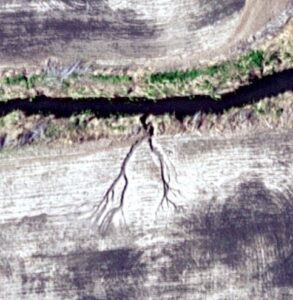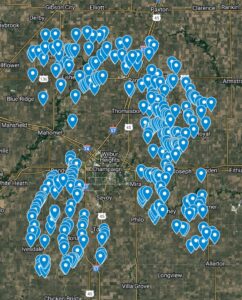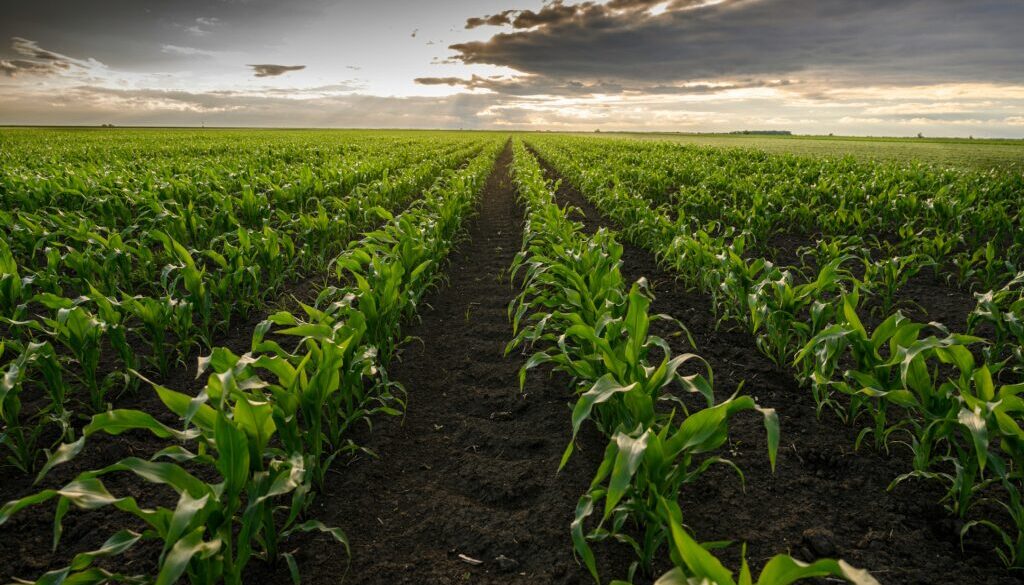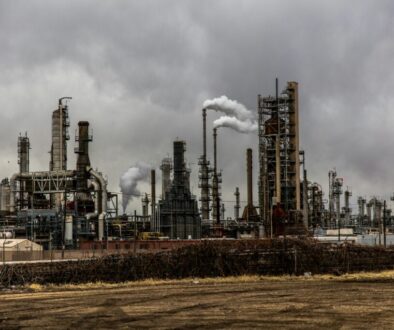Analysis raises concerns about potential misuse of atrazine weedkiller in US Midwest
By Douglas Main
Corn growers across Midwestern states appear to be flouting regulations aimed at protecting important waterways from contamination with toxic atrazine weedkiller, according to an analysis of satellite imagery and field data that comes as US regulators ponder changes to rules for use of the pesticide.
The analysis, which was conducted by an agricultural industry consultant in Illinois and shared with The New Lede, found what could potentially be thousands of violations by farmers in Illinois and neighboring states. The analysis honed in on geographic points where farm fields planted by corn growers are seen closely abutting waterways, and assumes that farmers sprayed their crops with atrazine, a common practice in the US Midwest.
Though it could not be determined if atrazine was used on the fields, the chemical is applied to the majority of corn acres in the state, and the satellite images show clear pathways for the flow of farm chemicals off the fields and into waters. Critics say the information exposes critical problems with current regulation of atrazine, which is known to pose an array of health risks to humans and animals and is considered a dangerous water contaminant.
The images and supporting data from the analysis were submitted this week to the US Environmental Protection Agency (EPA) by the Center for Biological Diversity (CBD), which also obtained the information from the consultant, who wishes to remain anonymous.
Though the analysis identified areas of concern in multiple states, it focuses on Illinois, the nation’s No. 2 corn-producing state. In just three counties of Illinois, and along key lakes that provide drinking water for the state, the analysis shows nearly 1,000 parcels of land where farmers planted corn and soybeans right up against rivers and streams and lakes, within required buffer zones where spraying atrazine is not allowed. (Farmers in the Midwest typically rotate planting corn and soy.)

Overall, there were more than 1,420 individual sites on the parcels of land where cropped area was less than the required 66 feet from the nexus where runoff enters streams or rivers, according to the analysis. There were more than 100 parcels with crops planted closer than the 200-foot margin required as a no-spray zone along the edges of drinking water lakes and reservoirs. These buffer zones, or setbacks, are spelled out on atrazine’s label.
“Given the high use of atrazine on corn in Illinois (estimated at 90%), the noted erosion adjacent to many of these fields, evidence of considerable channel runoff within many of these fields, and/or the presence of culverts/spillways that bypass filter strips in many of these fields, it is likely that many of these fields are a considerable source of atrazine in nearby surface water,” CBD said in its submission to the EPA.
The analysis and supporting data must be taken into account by the EPA as it finalizes new rules designed to reduce atrazine runoff and provide better protection for waterways against atrazine contamination, the CBD asserts. The public comment period on the new plan closes on Friday.
“Willful ignorance is no longer an option for EPA because we’re literally showing them how bad this problem is field-by-field in the most atrazine-contaminated state in the country,” said Nathan Donley, CBD’s environmental health science director.
A history of contamination
Atrazine is the second-most commonly used herbicide in the US and most Midwestern states. Farmers rely heavily on the effectiveness of atrazine in killing weeds in corn fields, in particular, but the ample use has created concerns for water quality across corn-growing states.
Research has shown that atrazine is an endocrine disruptor that has been linked to increased risk of various cancers, pre-term birth, birth defects, and diminished immune function.
Syngenta, the longtime maker of atrazine herbicides, paid over $100 million in 2012 to settle litigation with community water systems in six Midwestern states over atrazine contamination. But contaminated water has persisted as a problem.
In Illinois, the focus of the analysis, many creeks, lakes and reservoirs have been found to be contaminated with atrazine, including those supplying public drinking water. More than 50 water utilities serving more than 150,000 people in Illinois were found to have atrazine contamination in water supplies at levels that exceed health guidelines set by the Environmental Working Group (EWG), according to a recent EWG drinking water quality report.
With input from Syngenta, the agency has proposed making several changes to the rules around atrazine use, including establishing a “concentration-equivalent level of concern” (CELOC) at 9.7 parts per billion (ppb) in streams and lakes. That level is allowed before any mitigation efforts are required in any given watershed.
The new CELOC is nearly three times higher than the level of 3.4 ppb proposed by the EPA in 2016 and reiterated by the agency as properly protective in 2022. But it is lower than levels historically allowed. The agency says the new limits will not create any human health risks and will be protective of aquatic life, including fish and amphibians.
The agency additionally has proposed expanding the number of options of mitigation measures growers can choose from. The EPA describes its approach as aimed at providing “maximum flexibility (recognizing atrazine’s high benefits) while addressing the need for mitigation” of atrazine contamination.
Under the measures proposed by the EPA, in areas where concentrations of atrazine in water exceeds the CELOC, farmers can pick and choose from a point-based “mitigation menu” meant to promote practices that reduce runoff. Some farmers can achieve points based on the properties of their fields or actions they take that are associated with lower runoffs.
How many points farmers need varies by area, and includes factors such as quantity of rainfall, soil type, and whether or not farmers irrigate or till their land. Farmers need up to six points to comply with the proposed label’s instructions. Practicing no-till farming yields three points, as does not irrigating.
Critics say points are too easily achieved and will not do much to stop atrazine pollution of waterways. Looking only at Illinois as an example, using the field location analysis, the new mitigation plan would not reduce atrazine runoff in 99% of “runoff-vulnerable” fields in Illinois, CBD said. Even in watersheds where atrazine levels are more than four times higher than the CELOC, farmers would not need to do anything differently under EPA’s proposed mitigation plan, CBD said.
In the CBD comments that accompany the data from the Illinois analysis, the CBD told the EPA that the contamination problem overall is “frightening.”
“Atrazine contamination is so widespread that dangerous levels of the pesticide are predicted in waterways in 11,249 U.S. watersheds … out of 82,921 watersheds in the continental US,” the CBD wrote in its letter to the EPA. “That is 1/8th of the landmass of the entire continental US. The contaminated areas include about 20% of all land used for U.S. agriculture – roughly 250 million acres feeding into contaminated waterways throughout the country.”
Where fields and water meet
In the analysis conducted by the agricultural consultant, satellite imagery showed a range of routes where runoff from farm fields appears to be entering surface waters. In one example, the consultant identified a field where cropped areas abutted up against a stream cutting through the field. Six erosion points were identified where water, soil, and farm chemicals could be carried directly into the water.
The consultant said a complete assessment of Champaign County found 499 individual culvert/erosion points in 269 fields that border streams. Assuming the entire cropped area is sprayed, as is standard practice, those fields would be in violation of atrazine labels.

Looking at Illinois lakes that supply drinking water to residents, the analysis found that 14 of those lakes had at least one field where crops were planted within the 200-foot zone that is supposed to serve as a buffer against runoff.
And, as CBD reported to the EPA, there were 85 land parcels identified with “high runoff vulnerability” into the waterways that feed Lake Springfield, which serves 150,000 people and has a history of atrazine contamination problems. The imaging also shows sites of potential violations outside of properties managed by the Illinois Nature Preserves Commission, which include sensitive natural areas protected under state law. The properties include Wagon Lake, in southwestern Illinois and Calamus Lake, east of Springfield.
“There is substantial evidence of widespread chemical misuse” in Illinois and other corn-growing states, the analysis by the consultant concludes.
The Illinois Department of Agriculture, the agency that investigates pesticide misuse, declined an interview for this story, but spokesperson Lori Harlan said that “applicators are not required to submit their pesticide records, so the Illinois Department of Agriculture would not have a record of where atrazine applications occurred.”
Some of the landowners identified in the analysis owned fields showing multiple points of potential runoff, but those landowners did not respond to requests for comment, and it is not known if they in fact applied atrazine near the waterways.
Without landowner confirmation, it is impossible to know if the sites identified as potential sources of violations and atrazine runoff were sprayed with atrazine. Farmers could simply leave those cropped areas close to waterways unsprayed, or use a different weed treatment.
Leaving portions of fields unsprayed would be unusual, however, said Vernon Rohrscheib, a farmer who also works as an herbicide applicator in Fairmount, Illinois. “There’s not many corn acres that don’t get some form of atrazine,” he said.
Farmers or their hired applicators usually spray entire fields at a time, whenever possible. To spray a different herbicide mix on edges close to waterways, an applicator would have to load a different mix and come back a second time.
Illinois corn farmer Tom Smith said the potential violations were “a pretty big deal.” Smith, who also grows soybeans and other crops, said he quit using atrazine years ago due to environmental concerns. He now grows some crops organically, without the use of pesticides.
To truly reduce atrazine runoff and also atrazine drift, buffer zones, also called setbacks, are vital measures, and if farmers are not following those guidelines, it creates a significant problem, said Micheal Owen, a weed scientist and extension specialist who recently retired from Iowa State University.
“Anything that potentially compromises the environment is important, and wrong,” Owen said.
The EPA said it could not comment on the atrazine concerns. Syngenta did not respond to a request for comment.
(Carey Gillam contributed to this report.)
(Featured photo by Getty Images for Unsplash+.)
 EWG
EWG


